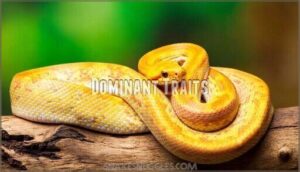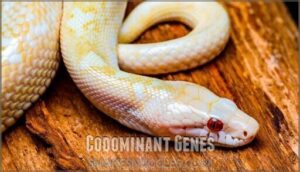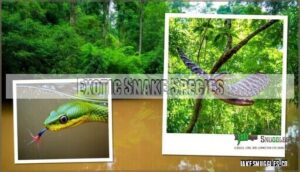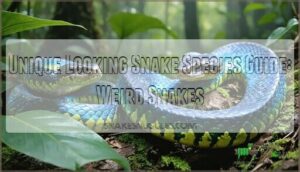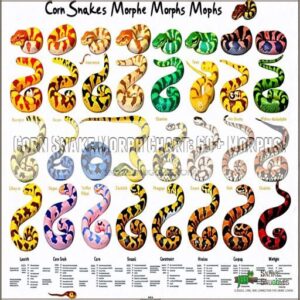This site is supported by our readers. We may earn a commission, at no cost to you, if you purchase through links.
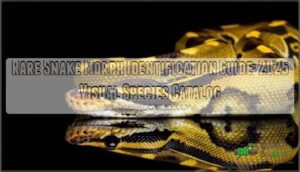 You’ll need to examine three key features when using this rare snake morph identification guide: color variations, pattern recognition, and scale textures.
You’ll need to examine three key features when using this rare snake morph identification guide: color variations, pattern recognition, and scale textures.
Look for base pigmentation changes, unusual stripe placements, and modified scale arrangements that signal genetic mutations.
These mutations occur at incredibly low rates—just 1.2 × 10^-8 per base pair per generation—making morphs like the Axanthic ball python appear in less than one in 100,000 offspring.
Market values reflect this rarity, with some morphs reaching $30,000.
Take photos under natural lighting and compare against established identification pictures for accurate results.
Understanding allele expression patterns helps predict breeding outcomes and confirms morph authenticity.
The genetic lottery that creates these stunning variations follows predictable inheritance patterns once you know what to look for.
Table Of Contents
- Key Takeaways
- Rare Snake Morphs
- Snake Morph Identification
- Corn Snake Genetics
- Garter Snake Subspecies
- Exotic Snake Species
- Frequently Asked Questions (FAQs)
- How do you identify a corn snake morph?
- What is a snake morph?
- What types of snakes are used to make Morphs?
- How many different morphs are there in a hognose snake?
- What are corn snake morphs?
- What are the coolest hognose snake morphs?
- What is the most expensive snake morph?
- What is the most sought after ball python morph?
- How can I tell what morph my ball python is?
- What is the hardest snake to identify?
- Conclusion
Key Takeaways
- You’ll need to examine three critical features for accurate identification: color variations in base pigmentation, pattern recognition including unusual stripe placements, and scale texture modifications that signal genetic mutations.
- You’ll find genetic mutations occur at extremely low rates of just 1.2 × 10^-8 per base pair per generation, making rare morphs like Axanthic ball pythons appear in less than one in 100,000 offspring with market values reaching $30,000.
- You’ll get accurate results by photographing specimens under natural lighting and comparing against established identification pictures from reputable sources, documenting any unusual features that don’t match standard descriptions.
- You’ll predict breeding outcomes and confirm morph authenticity by understanding allele expression patterns and inheritance types – dominant traits express with one copy, recessive traits need two copies, and codominant genes create intermediate expressions.
Rare Snake Morphs
You’ll find rare snake morphs when genetic mutations occur infrequently in breeding populations, making them valuable collector specimens.
These uncommon variants result from specific breeding practices, limited genetic combinations, and high market demand that can reduce their availability over time, leading to rare occurrences.
Genetic Mutation Frequency
Understanding genetic mutation frequency helps you identify rare snake morphs more effectively.
Mutation rates in captive colubrid snakes average 1.2 × 10^-8 per base pair per generation, while rare morphs like Axanthic ball pythons appear in less than 0.001% of clutch offspring.
Genetic lottery makes one in 100,000 ball pythons an extraordinary Axanthic treasure
Natural selection typically eliminates most mutations, but selective pressure in breeding programs increases morph prevalence dramatically compared to wild populations.
Breeding Practices
You’ll maximize rare morph production through selective breeding programs that target specific genetic combinations.
Line breeding concentrates desired traits while maintaining hybrid vigor in your bloodlines.
Responsible breeders focus on health screening and genetic diversity over profit margins.
Understanding allele expression is essential for predicting morph outcomes.
Research breeder reputation and ethical considerations before purchasing breeding stock for your program.
Market Demand
Understanding breeding practices helps you grasp why certain snake morphs command premium prices.
Market demand drives snake morph prices through collector enthusiasm and breeder influence. Morph popularity creates pricing dynamics where rare varieties fetch thousands while common types sell for under $100.
The initial investment depends on morph and genetics.
- Premium pricing trends: Rare morphs like Monsoon Ball Pythons reach $30,000 due to limited supply
- Market volatility: Snake morph rarity decreases as breeding increases, causing price drops within years
- Conservation impact: High-value morphs create breeding rushes that affect genetic diversity
- Ethical concerns: Overproduction leads to unsold snakes and potential welfare issues
Snake Morph Identification
Identifying snake morphs requires careful attention to specific visual markers. You’ll need to examine morph characteristics like color variations, pattern recognition details, and scale patterns systematically.
Hybrid identification becomes easier when you understand these fundamental traits.
| Visual Feature | What to Look For |
|---|---|
| Color Variations | Base pigmentation, contrast levels, saturation intensity |
| Pattern Recognition | Stripe placement, band width, saddle shapes |
| Scale Patterns | Texture differences, keeling presence, scale arrangement |
| Hybrid Identification | Mixed traits, intermediate expressions, unusual combinations |
Start with photographing your snake under natural lighting. Compare images against established snake morph identification pictures from reputable sources.
Document unusual features that don’t match standard descriptions – these often indicate rare snake morphs or unique genetic combinations worth further investigation. For milk snakes, understanding the morph pattern variations is key to accurate identification.
Corn Snake Genetics
You’ll need to understand corn snake genetics to identify rare morphs accurately. Genetic mutations affect pigment pathways through dominant, recessive, and codominant inheritance patterns that determine each snake’s unique appearance.
Dominant Traits
When you’re examining corn snake genetics, dominant genes express themselves with just a single copy from one parent.
These genetic traits override recessive alleles, making trait expression predictable in offspring. The Ultramel morph demonstrates dominant inheritance patterns perfectly – you’ll see vibrant yellows and oranges appear even when only one parent carries the gene.
Snake morph identification becomes straightforward since dominant snake morphs consistently show up in breeding programs, helping you predict inheritance patterns with confidence.
Understanding recessive gene requirements is also essential for predicting morph outcomes.
Recessive Traits
How do hidden alleles shape your snake breeding strategy?
Most corn snake morphs are recessive traits, meaning you’ll need two copies for trait expression.
Parents must both carry these masked genes to produce visual offspring.
Popular examples include albino and anerythristic morphs, which remain invisible in heterozygous carriers.
This makes predicting offspring challenging without genetic testing or careful lineage tracking for successful snake morph identification, particularly for identifying recessive traits.
Codominant Genes
Codominant genes create intermediate expression when two different alleles meet, producing blended traits that make visual identification tricky.
You’ll see this with Palmetto morphs—heterozygotes look hypomelanistic while homozygotes show distinctive white sprinkles.
These breeding outcomes produce unique combinations that don’t follow typical dominant-recessive patterns in snake genetics, creating intermediate expression.
Garter Snake Subspecies
You’ll find 13 distinct garter snake subspecies across North America, each with unique coloration patterns and geographic ranges that help identify them in the field.
Thirteen unique garter snake subspecies paint North America’s landscape with distinctive stripes and regional adaptations
Thirteen unique garter snake subspecies paint North America’s landscape with distinctive stripes and regional adaptations.
These subspecies differ from morphs because they’re naturally occurring genetic populations adapted to specific regions, from Alaska’s frozen tundra to Florida’s warm wetlands.
They are important to recognize as they have unique characteristics.
Geographic Range
Understanding garter snake geographic distribution helps you identify regional variations and potential introduced species across North America.
The genus Thamnophis spans from coast to coast, with subspecies showing distinct climate influence on their ranges and conservation status.
- Continental Spread – Garter snakes occupy all lower 48 U.S. states, Canadian provinces, and extend through Mexico to Costa Rica
- Habitat Overlap Zones – Common garter snakes demonstrate the widest distribution, while specialized subspecies like valley garter snakes occupy specific mountain regions
- Range Expansions – Regional introductions have established new populations, including documented spread in Newfoundland since 2010
Coloration Patterns
Garter snake color variations showcase nature’s artistic palette through distinct pigment alterations and pattern aberrations.
You’ll spot three longitudinal stripes in yellow, green, blue, gold, red, orange, or white against black, brown, or green backgrounds.
Some subspecies display checkered patterns with striking banding variations and scale iridescence that creates stunning visual effects when identifying snake morph types.
These variations can be influenced by specific color morphs and are a key part of understanding Garter snake characteristics, including their distinct pigment alterations and overall visual effects.
Habitat Preferences
You’ll find garter snakes thrive across diverse environments, from wetlands to suburban lawns.
Their adaptability makes them perfect for various captive setups when you understand their wild habitat requirements and regional variations.
- Aquatic environments – Western populations prefer marsh margins and stream edges
- Terrestrial spaces – Eastern subspecies occupy grasslands and forest clearings
- Urban microclimates – Parks and yards provide ideal enclosures for adaptation
- Communal hibernation sites – Protected areas enable cold-climate survival through antifreeze proteins
Creating the ideal garter snake enclosure involves careful planning.
Exotic Snake Species
You’ll encounter some of the world’s most unusual snakes when exploring exotic species from remote regions.
These remarkable serpents showcase incredible adaptations, from the tentacled snake’s unique sensory appendages to the gliding abilities of Southeast Asian flying snakes.
Southeast Asian Species
Southeast Asia’s rainforests harbor extraordinary snake species with remarkable adaptations.
You’ll encounter the Long-nosed Vine Snake using exceptional camouflage techniques, blending seamlessly with foliage through its thin green body.
The Blue Coral Snake displays striking red and blue patterns while possessing potent venom for hunting other snakes.
Arboreal adaptations shine in the Banded Flying Snake, which glides between trees.
The Tentacled Snake demonstrates unique aquatic hunting abilities in murky waters.
Some enthusiasts also seek out colorful pet snakes for their unique beauty.
Island-Endemic Species
Twenty-three island-endemic species showcase dramatic island evolution through unique adaptations.
You’ll spot the Golden Lancehead’s potent venom on Brazil’s Snake Island, where 2,000-4,000 individuals hunt migratory birds.
Santa Cruz Island Gopher Snake displays remarkable color morphs from green to grayish-white, reaching just 3ft.
These isolated populations face severe conservation challenges from habitat loss and invasive species, making proper snake identification essential for protection efforts.
Desert and Forest Species
Beyond isolated islands, desert and forest environments harbor equally remarkable snake species with specialized morphs.
You’ll find extreme camouflage adaptations among these exotic snake morphs, where snake genetic traits create stunning rare snake colors.
Conservation status remains critical due to habitat destruction.
Many seek to purchase unique snake morphs for collections.
- Inland Taipan – World’s most venomous with desert-adapted snake patterning
- Gaboon Viper – Two-inch fangs for rainforest diet specialization
- King Cobra – Venom toxicity targets other reptiles exclusively
- Reticulated Python – Snake alleles produce intricate geometric patterns
Frequently Asked Questions (FAQs)
How do you identify a corn snake morph?
Look for specific color patterns, stripe placement, and genetic traits.
Check for red pigmentation, black borders, and belly checkerboard patterns.
Compare against known morphs like Snow, Ghost, or Anerythristic using reference guides.
What is a snake morph?
A snake morph is a color or pattern variation within the same species, created by genetic mutations that alter pigmentation.
You’ll find morphs differ from wild-type snakes through selective breeding, not natural subspecies differences, which is a key point in understanding what constitutes a morph.
What types of snakes are used to make Morphs?
While exotic species like ball pythons create stunning morphs, you’ll primarily work with corn snakes and garter snakes.
Corn snakes offer over 800 morphs from selective breeding, while garter snakes provide natural subspecies variations for morph development.
How many different morphs are there in a hognose snake?
You’ll find dozens of different hognose morphs available to breeders and collectors.
Western hognose snakes alone have produced 25+ documented color and pattern variations through selective breeding and genetic combinations that showcase stunning diversity.
What are corn snake morphs?
Corn snake morphs are color and pattern variations created through genetic mutations.
You’ll find over 800 recognized morphs from 33 genetic strains, ranging from common varieties to rare specimens worth thousands of dollars.
What are the coolest hognose snake morphs?
You’ll find stunning hognose morphs like extreme red with contrasting white bodies and clear red spots, plus popular albino, anaconda, and dramatic toffee varieties with unique patterns.
What is the most expensive snake morph?
One remarkable record shows a high-blue green tree python sold for $445,800, making it likely the world’s priciest snake morph.
You’ll find rare ball python varieties commanding astronomical prices when genetics align perfectly.
What is the most sought after ball python morph?
You’ll typically find the Banana morph commands top prices among ball python enthusiasts.
It’s a sex-linked genetic trait that produces stunning yellow coloration and creates valuable "male maker" or "female maker" breeding stock for serious collectors.
How can I tell what morph my ball python is?
Like reading a genetic fingerprint, you’ll examine your ball python’s colors, patterns, and markings.
Compare photos against morph databases online, note inheritance patterns if you know the parents, and consult experienced breeders for confirmation.
What is the hardest snake to identify?
Identifying morphs becomes trickiest with complex multi-gene combinations like corn snake "snow ghosts" or ball python "super champagne pinstripes."
You’ll need genetic testing or detailed breeding records to confirm these rare combinations accurately.
Conclusion
Like a master jeweler examining precious gems, you’ve now learned to identify the subtle genetic treasures hidden within serpent scales.
Your rare snake morph identification guide skills will help you distinguish authentic morphs from normal variations.
Remember to photograph specimens under natural light and compare coloration patterns against established references.
Document scale textures and stripe placements carefully, as these identification techniques protect both collectors and breeders from costly mistakes.
Practice with common morphs first, then advance to rarer specimens worth thousands of dollars.
- https://resources.pangovet.com/pet-lifestyle/snakes/rarest-ball-python-morphs/
- https://www.lovetoknowpets.com/reptiles/unreal-ball-python-morphs-ranked-from-popular-rare
- https://a-z-animals.com/animals/snake/snake-facts/most-expensive-snakes-in-the-world/
- http://kpexotics.com/Main/2021/08/31/genetic-primer/
- https://community.morphmarket.com/t/genetics-morphs/4809

